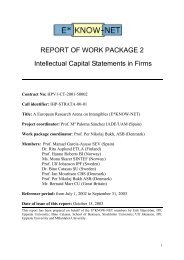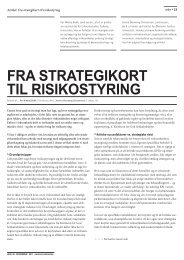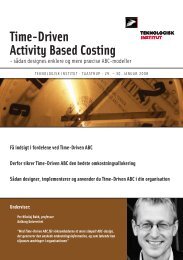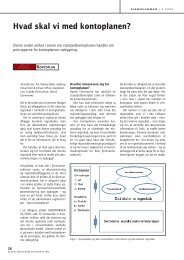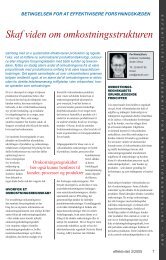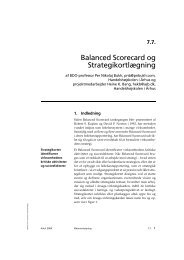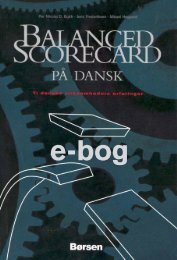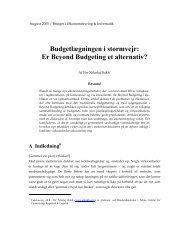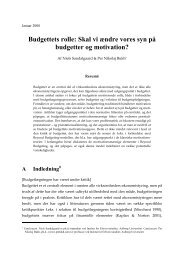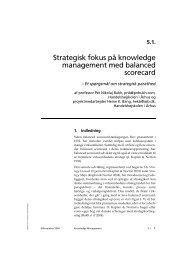guidelines for managing and reporting on intangibles (intellectual
guidelines for managing and reporting on intangibles (intellectual
guidelines for managing and reporting on intangibles (intellectual
You also want an ePaper? Increase the reach of your titles
YUMPU automatically turns print PDFs into web optimized ePapers that Google loves.
Structural capital is defined as the knowledge that stays within the firm at the end<br />
of the working day. It comprises the organizati<strong>on</strong>al routines, procedures, systems,<br />
cultures, databases, etc. Examples are organizati<strong>on</strong>al flexibility, a documentati<strong>on</strong><br />
service, the existence of a knowledge centre, the general use of In<str<strong>on</strong>g>for</str<strong>on</strong>g>mati<strong>on</strong><br />
Technologies, organizati<strong>on</strong>al learning capacity, etc. Some of them may be legally<br />
protected <str<strong>on</strong>g>and</str<strong>on</strong>g> become Intellectual Property Rights, legally owned by the firm under<br />
separate title.<br />
Relati<strong>on</strong>al capital is defined as all resources linked to the external relati<strong>on</strong>ships of<br />
the firm, with customers, suppliers or R&D partners. It comprises that part of<br />
Human <str<strong>on</strong>g>and</str<strong>on</strong>g> Structural Capital involved with the company’s relati<strong>on</strong>s with<br />
stakeholders (investors, creditors, customers, suppliers, etc.), plus the percepti<strong>on</strong>s<br />
that they hold about the company. Examples of this category are image, customers<br />
loyalty, customer satisfacti<strong>on</strong>, links with suppliers, commercial power, negotiating<br />
capacity with financial entities, envir<strong>on</strong>mental activities, etc<br />
As a result, the c<strong>on</strong>cept Intellectual Capital is embracing all kinds of <strong>intangibles</strong>, either<br />
<str<strong>on</strong>g>for</str<strong>on</strong>g>mally owned or used, or in<str<strong>on</strong>g>for</str<strong>on</strong>g>mally deployed <str<strong>on</strong>g>and</str<strong>on</strong>g> mobilized. Intellectual Capital is<br />
more than simply the sum of the human, structural <str<strong>on</strong>g>and</str<strong>on</strong>g> relati<strong>on</strong>al resources of the firm,<br />
it is about how to let the knowledge of a firm work <str<strong>on</strong>g>for</str<strong>on</strong>g> it <str<strong>on</strong>g>and</str<strong>on</strong>g> have it create value<br />
(Roberts, 1999). This can be achieved by creating the right c<strong>on</strong>nectivity between those<br />
resources through the appropriate intangible activities.<br />
3.3. Intangible Resources <str<strong>on</strong>g>and</str<strong>on</strong>g> Intangible Activities<br />
The different <strong>intangibles</strong> c<strong>on</strong>sidered in the three categories of <strong>intellectual</strong> capital<br />
defined in Box 1 can also be classified into Intangible Resources <str<strong>on</strong>g>and</str<strong>on</strong>g> Intangible<br />
Activities, according to their static or dynamic character.<br />
Intangible resources, following Hall’s (1992) proposal, can be c<strong>on</strong>sidered as assets in a<br />
broad sense; i.e., <strong>intellectual</strong> property rights, trademarks, certain in<str<strong>on</strong>g>for</str<strong>on</strong>g>mati<strong>on</strong><br />
technologies such as data bases, networks, or c<strong>on</strong>sidered as skills, i.e., capabilities <str<strong>on</strong>g>and</str<strong>on</strong>g><br />
competencies, such as those in human capital. The intangible resources of a company, a<br />
static noti<strong>on</strong>, can be measured at any given time. Thus, worker competences (human<br />
capital), <strong>intellectual</strong> property rights (structural capital), customer satisfacti<strong>on</strong> or<br />
agreements with suppliers (relati<strong>on</strong>al capital) would be c<strong>on</strong>sidered under this category.<br />
Intangible resources can also be analyzed in a dynamic sense. Companies are<br />
undertaking activities to acquire or internally produce intangible resources, to sustain<br />
<str<strong>on</strong>g>and</str<strong>on</strong>g> improve existing <strong>on</strong>es, <str<strong>on</strong>g>and</str<strong>on</strong>g> to measure <str<strong>on</strong>g>and</str<strong>on</strong>g> m<strong>on</strong>itor them. Although the activities<br />
undertaken are assumed to be costly, companies are not always able to measure <str<strong>on</strong>g>and</str<strong>on</strong>g><br />
keep track of these costs. These dynamic activities thus imply an allocati<strong>on</strong> <str<strong>on</strong>g>and</str<strong>on</strong>g> use of<br />
resources that are sometimes not expressed in financial terms, <str<strong>on</strong>g>and</str<strong>on</strong>g>, c<strong>on</strong>sequently, may<br />
or may not appear in the corporate financial reports.<br />
Intangible activities may give rise to new intangible resources, or improve the value of<br />
existing <strong>on</strong>es. For example, by re-qualifying them, or by increasing their ability to cooperate<br />
with other resources <str<strong>on</strong>g>and</str<strong>on</strong>g>, thus, improve their c<strong>on</strong>nectivity. Intangible activities<br />
also include the activities aimed at m<strong>on</strong>itoring <str<strong>on</strong>g>and</str<strong>on</strong>g> evaluating the results of those<br />
11



